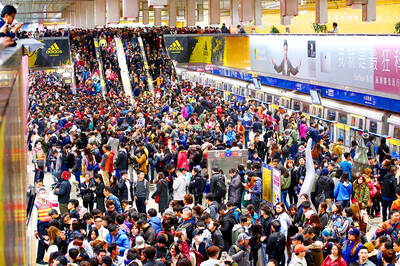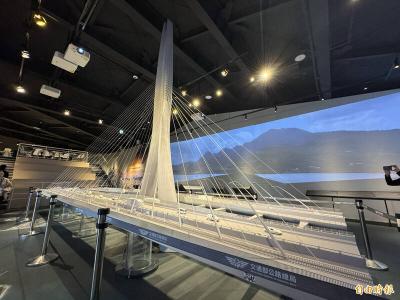A Chinese tourist injured when a crane boom landed on a tour bus on Friday passed away at 10:22am at Taipei Medical University Hospital yesterday.
All of Zhang Shiguang’s (張世洸) ribs were broken by the time the 63-year-old arrived at hospital. The rescue team put him on an extracorporeal membrane oxygenation system, which kept him alive for four days, before he was pronounced dead from multiple organ failure yesterday, raising the death toll from the accident to three.
Yao Ta-kuang (姚大光) of the Travel Agent Association said yesterday that he and a Tourism Bureau official had met the Taipei branch representative of Taisei Corp (大成營造), the company managing the construction site, and the latter had agreed to submit a written plan on how it would compensate the victims.
Yao said that officials from the Tourism Administration of Guangdong Province, who arrived on Saturday, also wanted matters of compensation to be resolved as soon as possible. They also hoped the government could honor the wishes of the families with regard to funerals and other matters. They also said they wanted doctors to make a judgment on whether the injured tourists were physically capable of making the trip home.
Yao also commented on a series of issues on accommodating the rising number of Chinese tourists, particularly the shortage of tour buses and the ability of facilities at some of the nation’s tourist attractions to handle the number of visitors.
More than 200 Chinese tourists have been stranded at airports and hotels because local travel agents failed to secure tour buses by the time they arrived.
A travel agent has been barred from handling Chinese tour groups for three months by the Tourism Bureau following the incidents.
“After the visit of Shao Qiwei (邵琪偉) of the China National Tourism Administration in February, some in China started to launch campaigns to bring more than 10,000 tourists to Taiwan this month,” Yao said. “In the meantime, however, a majority of the nation’s students were also taking graduation trips.”
He said the supply of tour buses returned to normal yesterday as the numbers visiting the nation this week has dropped to an average of 3,000 a day.
Yao said the association had met officials from the Tourism Bureau as well as the Department of Highways and Railways. He said the officials agreed to amend regulations that only tour buses that have been operating for less than seven years could carry Chinese tourists. Buses that have been in operation for more than 10 years and are equipped with engines larger than 7,000cc would also be allowed.
Yao said the tourists were stranded last week because the travel agent and a tour bus operator could not agree on price. While the travel agent only agreed to pay NT$7,500 for a tour bus, the bus company insisted it be paid more because of increasing demand for its buses.
Currently, a tour bus for hire costs up to NT$13,000 per day, including tips for the driver.
Yao said the association would establish official contact with the Tour Bus Association to better control the number of the tour buses being deployed.
To ensure the quality of travel services, Yao said tourist attractions such as Alishan and Sun Moon Lake must have a mechanisms to control the number of visitors. Yao hoped that the number of Chinese tourists visiting the nation would increase to 5,000 a day after regular cross-strait flight services become available.

READY: The CGA said it closely monitored China’s maritime exercise, deployed vessels to shadow the Chinese ships one-on-one and set up emergency response centers Chinese navy and coast guard ships have returned to China, signaling the end of a massive maritime exercise, authorities said yesterday. The Coast Guard Administration (CGA) released images it said showed Chinese vessels sailing north in rough seas past Taiwan on Thursday, on their way to China. “All the Chinese coast guard went back to China yesterday, so although they have not officially made any announcement, we consider it over,” CGA Deputy Director-General Hsieh Ching-chin (謝慶欽) said. Beijing has not confirmed the drills and the Chinese Ministry of National Defense did not say whether the maneuvers had taken place when asked at a

People can take the Taipei MRT free of charge if they access it at Nanjing Sanmin Station or Taipei Arena Station on the Green Line between 12am and 6am on Jan. 1, the Taipei Department of Transportation said on Friday, outlining its plans to ease crowding during New Year’s events in the capital. More than 200,000 people are expected to attend New Year’s Eve events in Taipei, with singer A-mei (張惠妹) performing at the Taipei Dome and the city government’s New Year’s Eve party at Taipei City Hall Plaza, the department said. As people have tended to use the MRT’s Blue or

PUBLIC TRANSPORT: As some roads would be fully or partially closed, people are advised to take the MRT, with services expanded to accommodate more riders This year’s Taipei Marathon, which has obtained its first gold label certification from World Athletics, is to be held from 5am to 1pm tomorrow and would have 28,000 participants. The race is to start from the Taipei City Plaza and would go through major roads throughout the city, with traffic control implemented from 6am to 2pm, officials said. The Taipei Mass Rapid Transit (MRT) system and New Taipei City MRT Circle line would start operating at 5am on the day of the race, they said. The race would cover Renai Road, Xinyi Road, Hangzhou S Road, Aiguo east and west roads,

Upon its completion next year, the new Tamkang Bridge (淡江大橋) in New Taipei City is to be an important landmark in Taiwan, alongside Taipei 101, Minister of Transportation and Communications Chen Shi-kai (陳世凱) said today. The bridge is scheduled to be completed in December next year and open to the public in the first half of 2026, connecting New Taipei City’s Tamsui (淡水) and Bali (八里) districts. It is an asymmetric single-tower suspension bridge, nearly 70 stories tall, designed by world-famous architect Zaha Hadid. The bridge aims to alleviate traffic in Tamsui and on the Guandu Bridge (關渡大橋), in addition to increasing the